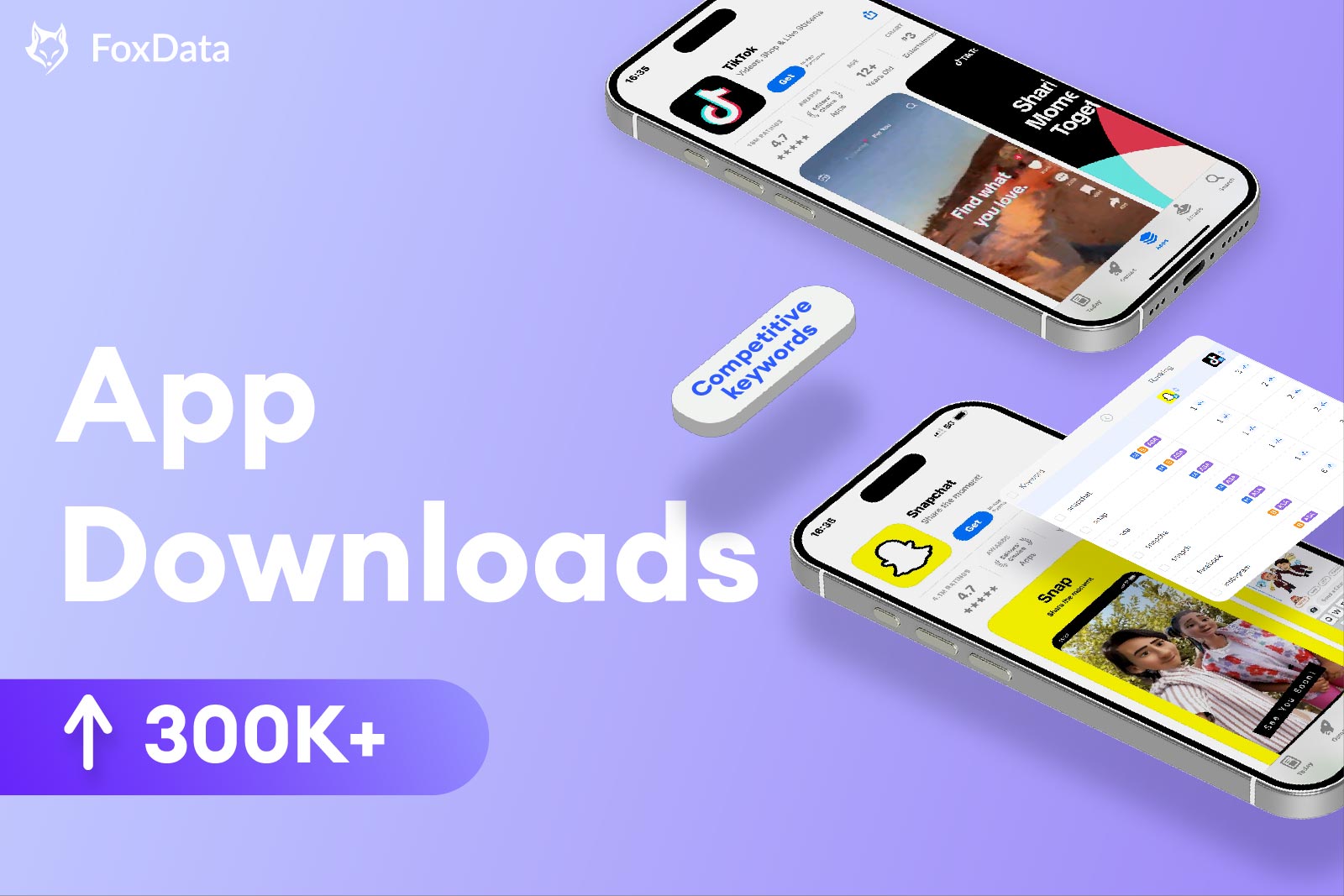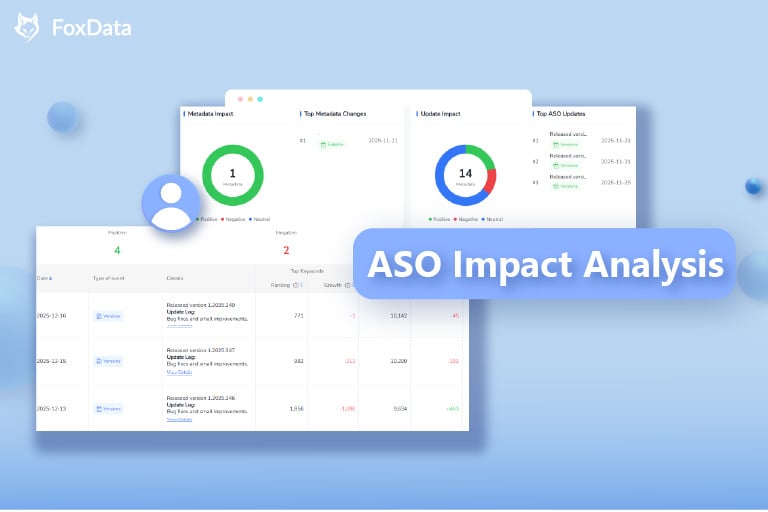How to Conduct Mobile App Competitor Analysis: A Practical Guide
Have you ever encountered this situation?
A new version has been launched, with significant product functionality improvements and even substantial budget allocated for user acquisition, yet the app's exposure and download volume in the app store still lag behind competitors.
Or, your marketing team has confidently optimized and tracked competitor keywords and categories, only to find themselves always a step behind—by the time you realize it, competitors have already quietly completed an update and captured new user mindshare.
What’s more frustrating is that you know their data must have a traceable pattern, but you struggle to systematically analyze their actual strategies on the App Store or Google Play.
Mastering a systematic and efficient competitive analysis method can help you achieve breakthroughs in the following key areas:
- Quickly identify and leverage competitors’ high-performing keyword combinations to boost organic traffic;
- Analyze competitors’ metadata update rhythms and visual positioning to provide testing samples for your ASO strategy;
- Gain market feedback intelligence through user review analysis to adjust product features and operational rhythms in advance;
- Guide your market and advertising strategies based on competitors' growth trajectories to reduce trial-and-error costs.
Next, we will walk you through how to conduct structured competitor analysis starting from the app store, combining real-world examples and tool usage methods to help you truly achieve “know thy enemy, and you will never be defeated.”
How to Conduct Mobile App Competitive Analysis
Step 1: Identify Your App Store Competitors
Before beginning any competitive analysis, you need to first define the scope of your competitors, including:
- Direct competitors: Apps that highly overlap with your product positioning, features, and target users. For example, Facebook and Twitter.
- Indirect competitors: Apps that, despite differing in product form, address the same core user needs.
How to identify them?
You need data to speak for itself, but you also need a method that avoids detours.
Use professional tools like FoxData to quickly obtain a list of competing apps related to your app and their performance metrics.
Use FoxData's Competitor feature to view recommended competitors
Step 2: Categorize your competitors structurally
Not all competitors carry the same weight; you need to categorize them structurally to optimize analysis efficiency:
- Market leaders: High download rankings and user activity;
- Direct competitors: Rankings close to yours, competing for the same users;
- Emerging threats: Small data but significant growth, potentially capable of “dark horse breakthroughs”;
- Potential players (long-distance competitors): Currently small in scale but possess certain product innovation or regional advantages.
Using FoxData's Visibility Score (combined with search keywords, visit rankings, etc.) can quickly complete initial screening and grading.
Step 3: Analyze competitors' ASO strategies and visual performance
1. Keyword optimization
- Which keywords are they ranking for?
- Are they frequently testing (updating) titles, subtitles, and descriptions?
- Are there any obvious “blind spots” in keyword coverage that you can capitalize on?
2. App store visual optimization
- Is the icon simple and distinctive? Is it updated regularly to align with campaigns?
- Do the first three screenshots highlight key value points?
- Are they using App Preview videos to engage users?
Tip: A high frequency of visual content updates often indicates they are running A/B tests.
You can use FoxData to track their visual update history to help analyze the logic behind their growth strategies
Step 4: Monitor competitors' advertising and store marketing trends
Performance in Apple Search Ads or Google UAC is also a key indicator of whether competitors are “heavily investing in the market”:
- What keywords are competitors targeting? Are they locking brand keywords or competing for traffic keywords?
- Are they using custom product pages (CPP) with different creatives for scenario-based targeting?
- Are they increasing ad budgets during key holidays or update cycles?
Step 5: Identify market opportunities through competitor user feedback
By analyzing competitor user reviews and rating trends, you can quickly identify their product strengths and user pain points:
- Which features or experiences receive the most positive reviews?
- What bugs or shortcomings are users repeatedly complaining about?
- Are there any unmet needs that users frequently mention?
These are not only important signals for product iteration but may also directly form the basis for your differentiated selling points.
FoxData can break down rating changes down to each version update
Step 6: Identify market gaps and plan profit model strategies
After thoroughly understanding the competition, you should try to answer these questions:
- Which niche user needs are being overlooked?
- In terms of functional pricing models, can higher cost-effectiveness/value-added features be used to gain an advantage?
- Are there “blue ocean” opportunities in regional markets? For example, Southeast Asia and Latin America have weak competition but rapidly growing search volumes.
- Are there AI/data-driven technologies for scenario personalization that can help establish competitive barriers early on?
Tool recommendation: Use FoxData's regional ranking analysis to quickly validate market coverage opportunities
Step 7: Continuously track and establish an executable monitoring mechanism
Competitive analysis should not be a one-off “project task” but a routine action in the growth process. Recommendations:
- Review changes in core competitors monthly (or quarterly);
- Set up“keyword ranking fluctuation” alerts using FoxData;
- Build your own competitor data dashboard to monitor download trends, rating changes, advertising movements, etc. in real time.
After analyzing your app store competitors, what should you do next?
Turn competitor analysis into growth strategies.
Conducting an in-depth competitive analysis is just the first step. The key is to translate these insights into concrete actions that optimize app performance, boost conversions, and enhance user experience.
Here are five actionable strategies you can implement immediately:
1. Optimize your ASO strategy
Your competitors' ranking performance can provide valuable reference for your ASO:
- Identify their high-ranking keywords and assess their traffic potential and relevance;
- Optimize your app title, subtitle, and description to cover more high-intent keywords;
- Borrow high-conversion icon and screenshot designs to strengthen visual assets;
- Conduct metadata A/B testing to identify the version that resonates most with your target users.
Using tools like FoxData for metadata comparison analysis can quickly uncover ASO optimization opportunities
2. Use competitor user feedback to reverse-engineer your product experience
Competitor review sections are a “free user research field”:
- Pay particular attention to recurring user complaints (e.g., lag, complex UI);
- Summarize user-favored highlight features to reflect genuine user needs;
- Proactively address issues unresolved by competitors to enhance your user experience (UX), interface design, and process guidance.
Better interaction experience → Higher retention and conversion rates → Stronger market competitiveness.
3. Optimize marketing and promotion channel strategies
Observe which channels competitors are focusing on and identify untapped opportunity areas:
- Replicate their successful elements on platforms like TikTok, Instagram, and YouTube;
- Analyze influencer collaborations and media resource distribution to identify similar resources for partnership discussions;
- Focus on platforms where they are absent (e.g., Reddit, LinkedIn) to capture cognitive gaps.
Optimizing marketing strategies and budget allocations can help you achieve better ROI with the same resources.
4. Adjust your revenue model strategy
Analyze competitors' monetization pathways, benchmark against them, and innovate:
- Avoid overly aggressive paywall settings to enhance user tolerance;
- Introduce progressive payment experiences, such as limited-time trials, tiered subscriptions, or ad-free versions;
- Monitor trends in pricing strategy updates to identify opportunities for differentiated pricing and promotions.
Note: Pricing models also impact conversion rates and user satisfaction, so they should be regularly optimized.
5. Implement continuous monitoring mechanisms to maintain a dynamic lead
Competitive analysis is not a one-time task; it should be part of your core growth strategy:
- Track competitors' new feature releases, major updates, and user feedback;
- Pay attention to visual adjustments and keyword changes on app store pages;
- Use tools such as FoxData to build an automated tracking system to receive timely notifications of changes and strategy adjustments.
Common pitfalls you may encounter
1. Blindly copying competitors' strategies
Do not assume that industry leaders' methods will work for you. Successful strategies are often closely tied to brand positioning, target users, and product features. For example, most racing games use landscape-oriented video content, but “Mario Kart Tour” adopts a portrait-oriented creative approach due to its portrait-oriented gameplay, which better aligns with user experience.
✅ Recommendation: Draw inspiration, but be sure to validate the strategy through A/B testing to ensure it suits your app, rather than simply adopting it as-is.
2. Ignoring indirect competitors
Focusing solely on functionally similar competitors may underestimate other apps competing for the same user attention. For example, a fitness app's potential competitors may not only include other fitness apps but also categories like meditation, sleep, and health management.
✅ Recommendation: Broaden your perspective and identify all apps targeting the same core audience and fulfilling similar needs.
3. Failing to update your competitor list
The app market changes rapidly; once-small players may rise quickly, while established players may decline due to strategic missteps.
✅ Recommendation: Regularly (e.g., quarterly) update your competitor list, especially when there are changes to the App Store algorithm, a large number of new releases, or industry shifts.
4. Ignoring user sentiment in reviews
Relying solely on star ratings is insufficient. Competitor review sections contain genuine user feedback, serving as both a “radar” for user pain points and a “barometer” for emerging trends.
✅ Recommendation: Analyze keywords and emotional tendencies to identify recurring user complaints about bugs or service shortcomings, thereby building your own product advantages.
FoxData's AI Review Summary allows you to gain deep insights into user preferences or dissatisfactions, which you can use to update your application
5. Focusing solely on short-term adjustments
Frequently making rapid, minor adjustments to existing strategies in response to competitor dynamics without a clear long-term growth plan can lead to brand confusion and resource waste.
✅ Recommendation: While incorporating short-term operational suggestions, also focus on building differentiated competitiveness, product evolution pathways, and user retention capabilities.
6. Ignoring marketing-level competition
Many developers only look at competitors' product pages and ASO performance, but overlook their strategies for acquiring users online and offline. Have they run social ads? Have they partnered with influencers? Have they actively sought store recommendations? These dynamics reveal clues about where the “target market” is and what the key scenarios are.
✅ Recommendation: Continuously monitor competitors' marketing activities to identify their user growth sources and potential promotional opportunities.
🧭 Everything starts with data—data-driven growth.
🎯 Start your free trial now ›
📧 Contact us for customized report solutions
📢 Follow FoxData's official blog and social media for more industry insights.
FAQ
1. Why is competitor analysis critical for ASO?
Through competitor analysis, you can identify market trends, extract high-performing keywords, optimize visual performance, and refine positioning and pricing strategies to enhance your app's visibility and conversion performance.
2. How do I identify my direct competitors?
Look for apps with similar functionality and targeting the same user base. Use charts, keyword searches, or competitor analysis tools like FoxData to quickly identify them.
3. What tools can be used to analyze App Store competitors?
Using FoxData, you can track core information such as competitors' keyword coverage, metadata updates, user review sentiment, in-app activities, and creative material changes.
4. How often should I conduct a competitive analysis?
It is recommended to conduct one every 3–6 months, or activate “competitor review” during major version updates, new competitor launches, or App Store ranking fluctuations to ensure strategies keep pace with market changes.
5. Which ASO metrics should be prioritized during analysis?
Keyword rankings, category charts, download trends, conversion rates, rating distributions, sentiment word analysis, and visual creative update frequencies.
6. How can competitive analysis improve my app's rankings?
Identify competitors' keyword strategies and content expression methods, analyze their uncovered opportunity keywords and visual differences, and optimize ASO layout and creative testing to stand out.
7. How can I use competitors' user reviews to improve my app?
Extract recurring negative feedback and feature requests from competitors' reviews, address user pain points proactively, establish a differentiated advantage, and win back potential churn users.
8. What should I do when competitors launch major features or version updates?
Monitor user feedback. If there is negative feedback, immediately adjust your ASO or advertising strategy for differentiated targeting; if users approve of their new features, you may also consider strategically optimizing or iterating related experiences.







